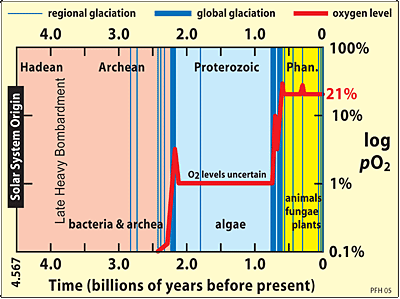Near the beginning and end of the Proterozoic Eon, circa 2220 Ma ("Makganyene"), circa 710 Ma ("Sturtian") and circa 640 Ma ("Marinoan").
The last snowball earth ended 635 million years ago (Ma), near the end of the
Proterozoic Eon. For reference, the oldest
bilaterian animal fossils (555 Ma in Arctic Russia) are 80 million years younger. This snowball earth is often referred to as "Marinoan", after glacial sediments in South Australia described in 1949 by the geologist and famed Antarctic explorer,
Sir Douglas Mawson. Sedimentary deposits from this glaciation are found on virtually all continents, and were recognized in Arctic Norway as long ago as 1891 by the geologist
Hans Reusch. It has been estimated in different ways that the Marinoan snowball earth lasted for 6-12 million years, but none of the estimates is highly reliable. No suitable material has yet been found to date the initiation of the Marinoan snowball earth, but it must have occurred after ~663 Ma.
The penultimate snowball earth occurred around 710 Ma and like the Marinoan its sedimentary deposits are found on virtually every continent. It is commonly referred to as "Sturtian", after glacial sediments in South Australia described in 1908 by the geologist
Walter Howchin. Attention is drawn to these deposits because they contain large sedimentary iron deposits ("
banded iron formation", or BIF) in different areas. Neither the initiation nor termination of the Sturtian snowball earth has been directly dated, although some evidence suggests that it lasted for millions of years. Its initiation was definitely later than 746 Ma.

The oldest snowball earth goes all the way back to ~2200 Ma, which is nearly half the age of the Earth (4567 Ma). The present distribution of glacial deposits is quite limited, occurring principally in South Africa as the Makganyene (Mak-han-yee-nee) Formation. They are believed to represent a snowball earth because paleomagnetic evidence (of Earth"s past magnetic field "fossilized" in rock) suggests they were deposited close to the equator. This finding was reported in 1997 by David Evans, Nic Beukes and
Joe Kirschvink (who named and recognized the cyclic nature of snowball earths). The Makganyene snowball earth is
broadly associated in time with the rise of "free" oxygen, molecular O
2, the most profound revolution of the Earth"s surface (atmosphere, oceans, crust and life) in its entire history. There is astonishingly little evidence for even regional-scale glaciation in the 1.3 billion years between the Makganyene and Sturtian snowball earths.
There are glacial sedimentary deposits ~200 million years older than the Makganyene in central North America and northern Europe that could conceivably represent more ancient snowball earths (well-recognized glacial sediments go back to ~2900 Ma, again in South Africa), but there is little to make a case for global glaciation. Similar deposits on the island of Newfoundland, Canada, have been dated near 580 Ma, 55 million years after the Marinoan snowball earth ended. These are only ~5 million years older than the first fossils beds of Ediacara (large soft-bodied modular organisms unassignable to extant phyla) in the same area. A snowball earth has been postulated for this glaciation but the evidence is inconclusive.